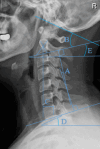Zero-profile implant system versus novel plate systems after ACDF for comparison of sagittal balance parameters and clinical efficacy analysis
- PMID: 38898467
- PMCID: PMC11186272
- DOI: 10.1186/s13018-024-04857-y
Zero-profile implant system versus novel plate systems after ACDF for comparison of sagittal balance parameters and clinical efficacy analysis
Abstract
Background: The zero-profile implant system (Zero-P) and conventional plates have been widely used in anterior cervical discectomy and fusion (ACDF) to treat cervical spondylosis. The purpose of this study was to compare the effects of the application of Zero-P and new conventional plates (ZEVO, Skyline) in ACDF on the sagittal imaging parameters of cervical spondylosis patients and to analyze their clinical efficacy.
Methods: We conducted a retrospective study on 119 cervical spondylosis patients from January 2018 to December 2021, comparing outcomes between those receiving the Zero-P device (n = 63) and those receiving a novel conventional plate (n = 56, including 46 ZEVO and 10 Skyline plates) through ACDF. Cervical sagittal alignment was assessed pre- and postoperatively via lateral radiographs. The Japanese Orthopedic Association (JOA), Neck Disability Index (NDI), and visual analog scale (VAS) scores were recorded at baseline, after surgery, and at the 2-year follow-up to evaluate patient recovery and intervention success.
Results: There were significant differences in the postoperative C0-C2 Cobb angle and postoperative sagittal segmental angle (SSA) between patients in the novel conventional plate group and those in the Zero-P group (P < 0.05). Postoperatively, there were significant changes in the C2‒C7 Cobb angle, C0‒C2 Cobb angle, SSA, and average surgical disc height (ASDH) compared to the preoperative values in both patient groups (P < 0.05). Dysphagia in the immediate postoperative period was lower in the Zero-P group than in the new conventional plate group (0% in the Zero-P group, 7.14% in the novel conventional plate group, P = 0.046), and the symptoms disappeared within 2 years in both groups. There was no statistically significant difference between the two groups in terms of complications of adjacent spondylolisthesis (ASD) at 2 years postoperatively (3.17% in the Zero-P group, 8.93% in the novel conventional plate group; P = 0.252). According to the subgroup analysis, there were significant differences in the postoperative C2‒C7 Cobb angle, C0‒C2 Cobb angle, T1 slope, and ASDH between the ZEVO group and the Skyline group (P < 0.05). Compared with the preoperative scores, the JOA, NDI, and VAS scores of all groups significantly improved at the 2-year follow-up (P < 0.01). According to the subgroup analysis, the immediate postoperative NDI and VAS scores of the ZEVO group were significantly better than those of the Skyline group (P < 0.05).
Conclusion: In ACDF, both novel conventional plates and Zero-P can improve sagittal parameters and related scale scores. Compared to the Zero-P plate, the novel conventional plate has a greater advantage in correcting the curvature of the surgical segment, but the Zero-P plate is less likely to produce postoperative dysphagia.
Keywords: ACDF; Sagittal balance parameters; Skyline; ZEVO; Zero-P.
© 2024. The Author(s).
Conflict of interest statement
The authors have no relevant financial or non-financial interests to disclose.
Figures





Similar articles
-
Correlation analysis between preoperative odontoid incidence and clinical outcomes 2 years after anterior cervical discectomy and fusion.J Orthop Surg Res. 2025 Jan 12;20(1):42. doi: 10.1186/s13018-024-05421-4. J Orthop Surg Res. 2025. PMID: 39800707 Free PMC article.
-
[Comparison of effectiveness between zero-profile anchored cage and plate-cage construct in treatment of consecutive three-level cervical spondylosis].Zhongguo Xiu Fu Chong Jian Wai Ke Za Zhi. 2025 Feb 15;39(2):193-200. doi: 10.7507/1002-1892.202410092. Zhongguo Xiu Fu Chong Jian Wai Ke Za Zhi. 2025. PMID: 39971365 Free PMC article. Chinese.
-
[Correlation analysis between preoperative C 2 slope and effectiveness at 2 years after short-segment anterior cervical discectomy and fusion].Zhongguo Xiu Fu Chong Jian Wai Ke Za Zhi. 2025 Mar 15;39(3):341-345. doi: 10.7507/1002-1892.202409010. Zhongguo Xiu Fu Chong Jian Wai Ke Za Zhi. 2025. PMID: 40101910 Free PMC article. Chinese.
-
Multilevel Anterior Cervical Diskectomy and Fusion with Zero-Profile Devices: Analysis of Safety and Feasibility, with Focus on Sagittal Alignment and Impact on Clinical Outcome: Single-Institution Experience and Review of Literature.World Neurosurg. 2017 Oct;106:724-735. doi: 10.1016/j.wneu.2017.06.051. Epub 2017 Jun 15. World Neurosurg. 2017. PMID: 28625909 Review.
-
Zero-profile implant versus conventional cage-plate construct in anterior cervical discectomy and fusion for the treatment of single-level degenerative cervical spondylosis: a systematic review and meta-analysis.J Orthop Surg Res. 2022 Nov 24;17(1):506. doi: 10.1186/s13018-022-03387-9. J Orthop Surg Res. 2022. PMID: 36434694 Free PMC article.
Cited by
-
Contiguous Two-Level Anterior Cervical Discectomy and Fusion Using Zero-P VA System: A Retrospective Study.Orthop Res Rev. 2025 May 16;17:213-220. doi: 10.2147/ORR.S517491. eCollection 2025. Orthop Res Rev. 2025. PMID: 40395935 Free PMC article.
-
Recent progress in surgical treatment of cervical spine myelopathy - A narrative review.J Clin Orthop Trauma. 2025 May 26;68:103074. doi: 10.1016/j.jcot.2025.103074. eCollection 2025 Sep. J Clin Orthop Trauma. 2025. PMID: 40529237
References
Publication types
MeSH terms
LinkOut - more resources
Full Text Sources
Medical
Research Materials
Miscellaneous

